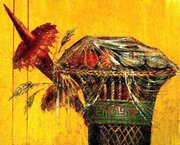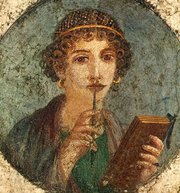Gallery of Pompeii and Herculaneum
|
|
This is a gallery of a few very interesting images and objects from ancient Pompeii, preserved by the eruption of Mount Vesuvius in 79 CE. Erotic images and a discussion there of can be found in a separate article.
 This extraordinarily well preserved image makes remarkable use of perspective and color to create an immersive, almost photorealistic view. It is unknown what the function of the orb on the table is, perhaps it is a glass bowl with a butterfly pattern on it. |  From looking at ruins, it is easy to get the idea that ancient Roman cities were dull and single-colored -- after two thousand years, statues and buildings have often completely lost their color. This fresco gives a more accurate picture of how an ancient city actually looked, and also makes impressive (albeit not entirely accurate) use of perspective. The attention to detail is remarkable, such as the wind blowing the plants, or the curtains in the window (which appear to have motives on them). Also note the painted column and the gilt statue. |
The above two images are part of this room:
 Here we see a basket, probably with strawberries and some other food. Still lifes like that were popular in Pompeii, but this one is remarkable for its degree of preservation and artistic quality. It is unclear what the transparent material covering the fruits is, it appears to reflect light and does not show the characteristic patterns of thinly weaved cloth. | Missing image Pompeii_Painter.jpg This image of a painter shows both a framed painting and a painted statue (believed to be Priapus). Since the framed painting is complete, it is unclear why it is held by the boy. It is too far away to be easily accessible and too dissimilar from the statue to be its model. The framed painting seems to be made of glass, as the background shines through. Note that a picture frame has been painted around the fresco itself. From Homo Faber: Natura, scienza e tecnica nell'antica Pompei a cura di M.R. Borriello, A. Ciarallo, S. De Caro, E. De Carolis, G. Di Pasquale,P. Galluzzi, P. G. Guzzo. Milano: Eclecta, 1999. |
Missing image Herculaneum_Fresco_001.jpg This fresco from a house in Herculaneum contains something strange: The small woman on the left appears to have no legs. On closer look, we notice that a lever appears to be mounted within the right arm of the figure, moving in a slit up and down. Possibly a kind of club is attached to this lever, beating against the box held by the figure. There is also a slot at the bottom of the figure, part of something that looks like a drawer extruding from the figure. To the bottom right of the figure there is a straight line, which may indicate that it is standing in or mounted on a niche. Given the proportions, the slot at the bottom, the missing legs, and the lever, it seems natural to assume that this is a mechanical device, possibly a clock, and not a human being. (As noted above, statues in ancient Rome were typically painted.) (Image color-corrected but not retouched.) |  So-called Sappho, fourth style fresco; Pompeii, Region VI, Insula occidentalis. A young woman is shown with a pen that is used to enscribe writing on the wax tablets she is holding. The net in her hair is made of golden threads and typical for the fashion of the Neronian period. | Missing image JMG242.jpg |
